Here’s Our In-Depth Comparison of Typeform vs Google Forms vs Growform
Quick Summary
This article compares Typeform and Google Forms across design, logic, integrations, and overall usability for lead generation. It also introduces Growform, a platform built for high-converting, multi-step forms. For more tips on building forms that drive results, visit our blog.
Typeform vs Google Forms: Which is a Better Choice?
Typeform and Google Forms are both popular form builders, and for good reason. Typeform offers sleek, customized forms that feel more interactive. Google Forms keeps things simple, making it easy to create and share basic forms quickly. But are they built for lead generation?
If you’re running paid campaigns or collecting high-value leads, your form builder needs to do more than just gather responses. It should help you qualify users, track performance, and drive conversions.
In this Growform article, we’re comparing these tools side by side, highlighting what each one does well, where they fall short, and which is best for lead generation.
Why Listen to Us?
At Growform, we’ve helped lots of marketers and businesses build forms that have increased their conversion rates. We’ve seen what converts, what causes drop-offs, and where general-purpose form builders fall short. This review is grounded in real user feedback and a clear understanding of what it takes to turn traffic into qualified leads.
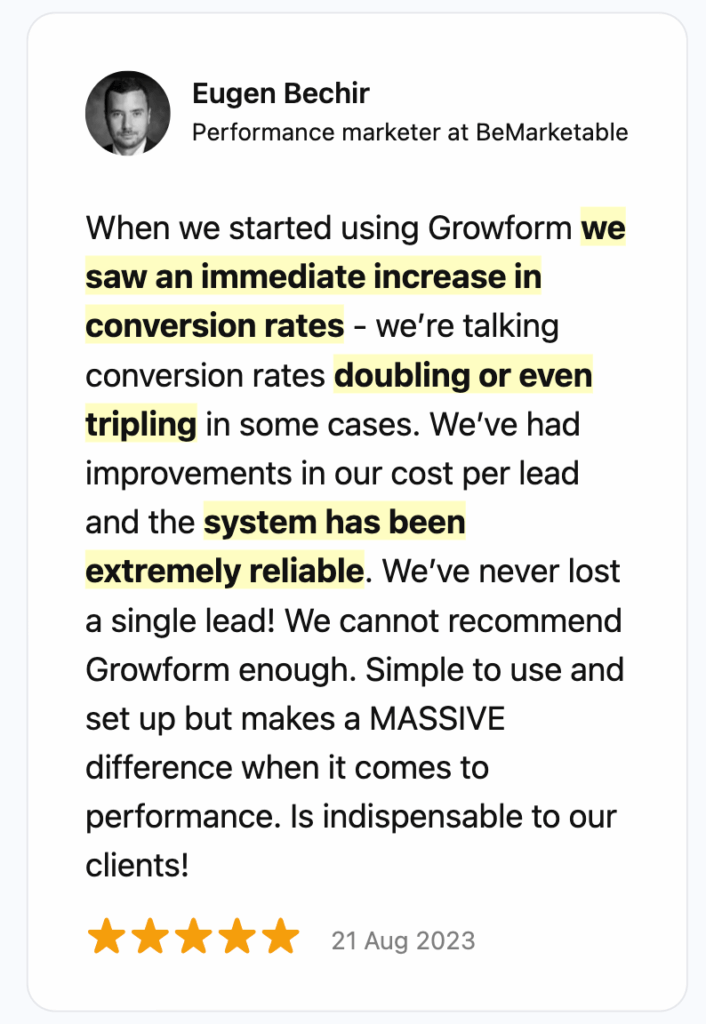
Typeform vs Google Form: Key Differences
Typeform and Google Forms are two of the most widely used form builders, but they serve different purposes. Typeform is more design-forward, with a focus on delivering a smooth, one-question-at-a-time experience.
Google Forms, on the other hand, is built for speed and simplicity, great for internal use or quick data collection. Both tools can create forms, but the way they handle design, logic, and user experience sets them apart.
Here’s how they stack up against each other:
Typeform
- Offers advanced customization, including fonts, colors, and branding
- Includes logic jumps and branching for more personalized form journeys
- Better suited for external-facing forms where presentation and engagement matter
- Integrates with popular tools like HubSpot, but more advanced functionality requires upgrading.
Google Forms
- Uses a traditional, scrollable layout with all questions on one page
- Seamless integration with Google Sheets and other Google Workspace tools
- Completely free to use, with no limits on form submissions
- Limited design flexibility with few customization options
Both tools get the job done. While Typeform is a better fit for marketers focused on form design and engagement, Google Forms wins on simplicity and cost.
What Is Typeform?
Typeform is a digital form builder that makes online interactions feel more personal and engaging. It’s widely used by businesses, marketers, and creators who want a more polished alternative to traditional forms.
Rather than focusing purely on data collection, Typeform customizes the overall experience, positioning itself as a tool for better conversations, not just submissions. It’s often used for brand-facing use cases like surveys, feedback forms, and lead capture pages where presentation matters.
Key Features
- “One Question at a Time” Layout: Presents questions one at a time to reduce overwhelm and create a smooth, interactive flow.
- Conditional Logic: Shows or skips questions based on previous answers to personalize the form experience.
- Advanced Logic & Branching: Logic Jumps let you tailor question flow based on user responses, creating dynamic, personalized paths.
- Workflow Automation: Workflow Builder automates follow-up emails, Slack notifications, and CRM updates, no developer needed.
- AI-Powered Form Building: Includes Creator AI for assisted form creation, Insights AI for analysis, and Interaction AI to enhance data quality.
Pricing
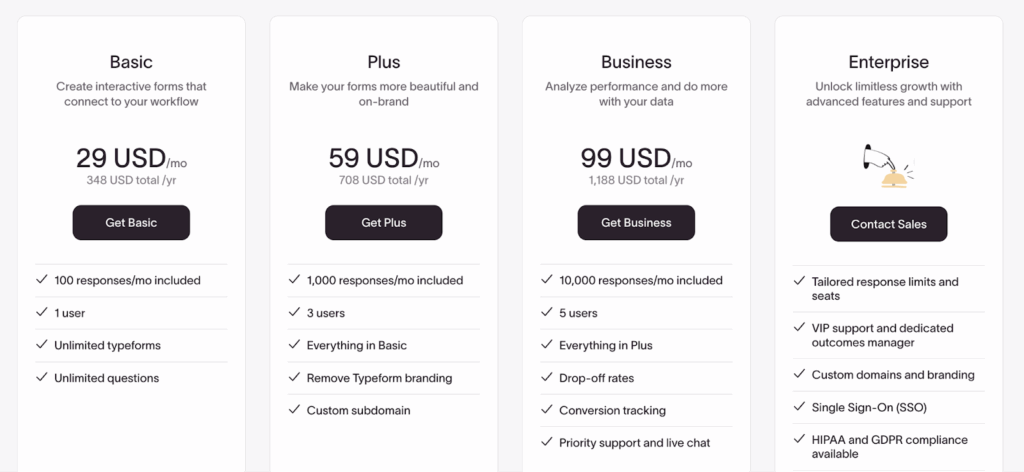
- Free: Includes unlimited forms and up to 10 questions, but limits you to 10 responses per month.
- Basic ($29/month): For creating interactive workflows that adapt to your workflow
- Plus ($59/month): For more customization and branding options
- Business ($99/month): Offers more features that support analytics for form performance
- Enterprise (custom pricing): Advanced features and support
Pros
- Supports advanced conditional logic to personalize form paths
- The forms load quickly and display well on any device
- Simple embed and share options for websites, emails, and landing pages
- AI features can speed up form creation and help you get better insights from your data.
Cons
- Internal reporting tools are limited
- Fewer lead-tracking tools compared to specialized lead-gen form builders
- Forms with lots of logic or media can sometimes feel slow to load or edit.
- If speed and simplicity are your top priorities, the design-first approach might feel like too much.
What Is Google Forms?
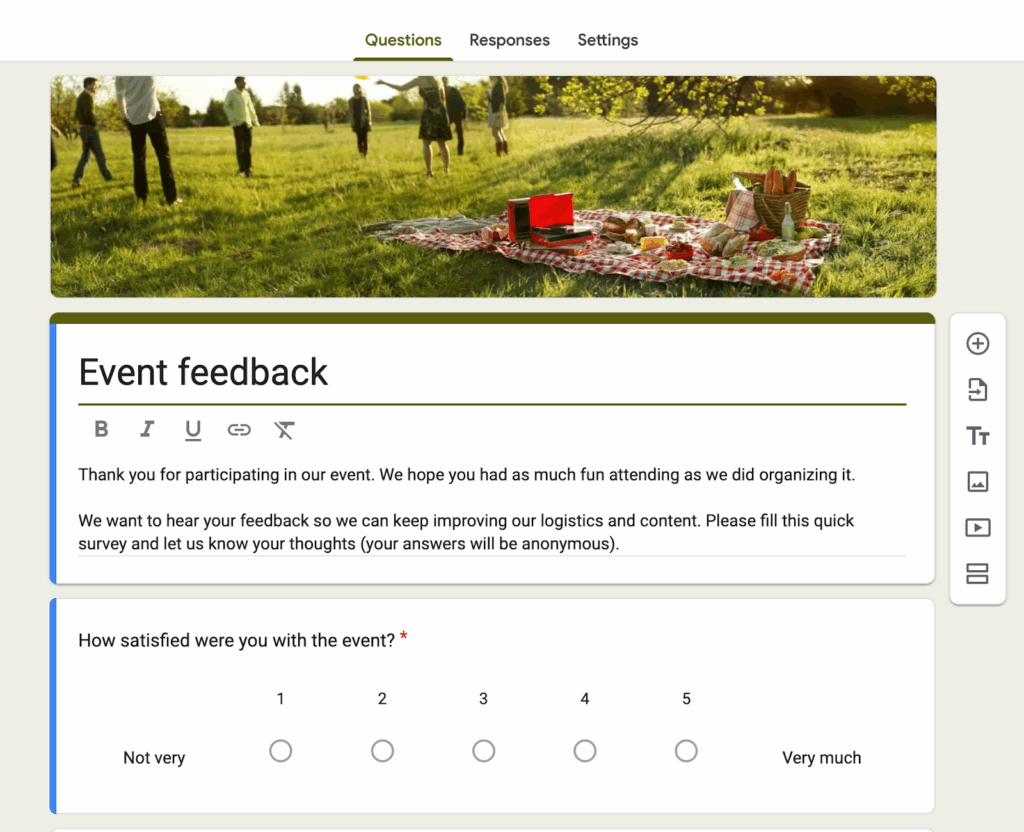
Google Forms is a free, lightweight form builder that’s part of the Google Workspace suite. It’s widely used by schools, businesses, and individuals for collecting information quickly and easily. Users can build and share forms without any technical experience.
Because it’s deeply integrated with other Google tools, it fits seamlessly into existing workflows for teams already using Google Workspace. However, it’s less used in scenarios where brand experience or conversion performance is a priority.
Key Features
- Wide Variety of Question Types: Choose from multiple-choice, checkboxes, dropdowns, short answer, paragraphs, file uploads, scales, grids, date/time fields, and more.
- Conditional Logic & Sections: Use branching logic to direct respondents through sections based on their responses.
- Custom Themes and Branding: Customize each form with header images, theme colors, backgrounds, and font choices.
- File Upload Capability: Respondents can upload documents, images, or files directly through the form, while it’s stored immediately in Google Drive.
- Real-Time Response Collection and Analytics: View results instantly as submissions are received, backed by summary charts, visual breakdowns, and automatic Google Sheets integration.
Pricing
Google Forms is free for anyone with a Google account.
Pros
- It’s completely free, with no limits on forms or responses
- The interface is simple and familiar, especially for anyone already using Google Workspace tools like Docs or Sheets.
- Forms are quick to create and easy to share via link, email, or embed.
- Responses are automatically collected in Google Sheets, which makes organizing and analyzing data fast and seamless.
Cons
- Customization is very limited
- It lacks advanced features like multi-step forms, pixel tracking, or dynamic lead routing.
- Forms show all questions at once, which can feel overwhelming or cluttered for long forms.
- While you can use add-ons, setup can be time-consuming.
A Better Alternative to Typeform and Google Forms: Growform
Typeform delivers polished, user-friendly forms. Google Forms keeps things simple and accessible. But when it comes to capturing leads, fast and at scale, both tools come up short.
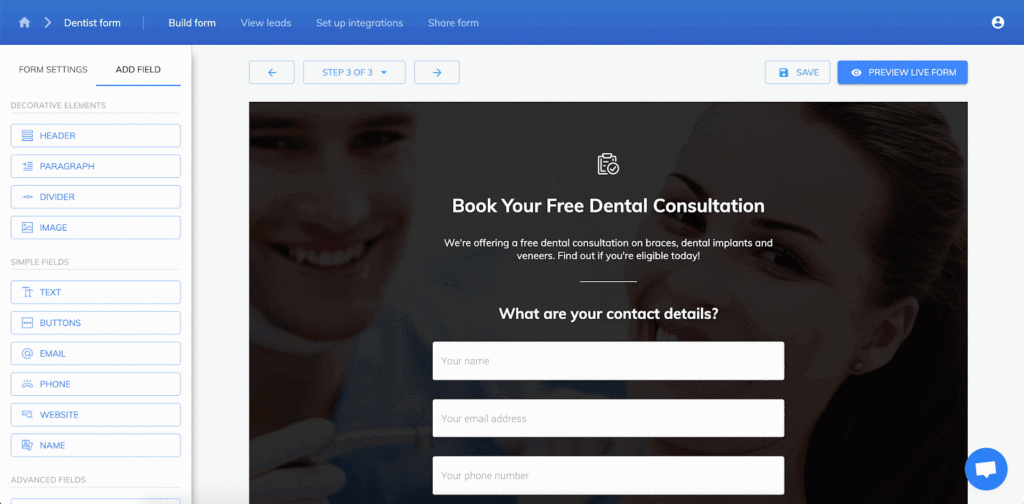
That’s where Growform stands out. It’s built specifically for lead generation, with multi-step forms, built-in tracking, and smart logic that work out of the box. You don’t need to change how you collect data. You just get more control, better-qualified leads, and a form experience designed to boost conversions from the start.
Key Features
- Multi-Step Forms by Default: All Growform forms are designed as multi-step by default, making it easier to break longer forms into digestible sections.
- Conditional Logic & Branching: Growform supports advanced “and/or” conditional logic to tailor the form journey based on user inputs.
- Hidden Fields & UTM Capture: Easily capture parameters like UTM campaign, ad group, or referral data for analytics and lead attribution.
- Built-In Pixel Firing: Configure forms to automatically fire ad tracking pixels on submission, no need for extra scripts or setup.
- Instant Lead Notifications: Receive real-time SMS or email alerts when a form is submitted, enabling you to act on leads immediately.
- Extensive Integrations: Growform connects with 5,000+ tools through Zapier, and supports email and webhook-based integrations for flexible workflows.
- Conversion-Optimized Templates: Choose from over 100 psychology-backed, industry-specific designs that are optimized for lead capture in fintech, real estate, and more.
- Custom Styling & CSS: Design forms with full branding control, custom fonts, button styles, progress bars, colors, and CSS support.
- Advanced Field Types: Use 25+ conversion-focused fields (address lookup, progress bars, buttons, validation, checkboxes) to enrich lead data.
- Fast Hosting & Easy Embeds: Forms load fast via Cloudflare and embed anywhere using one-line HTML, no plugins or coding required.
Pricing
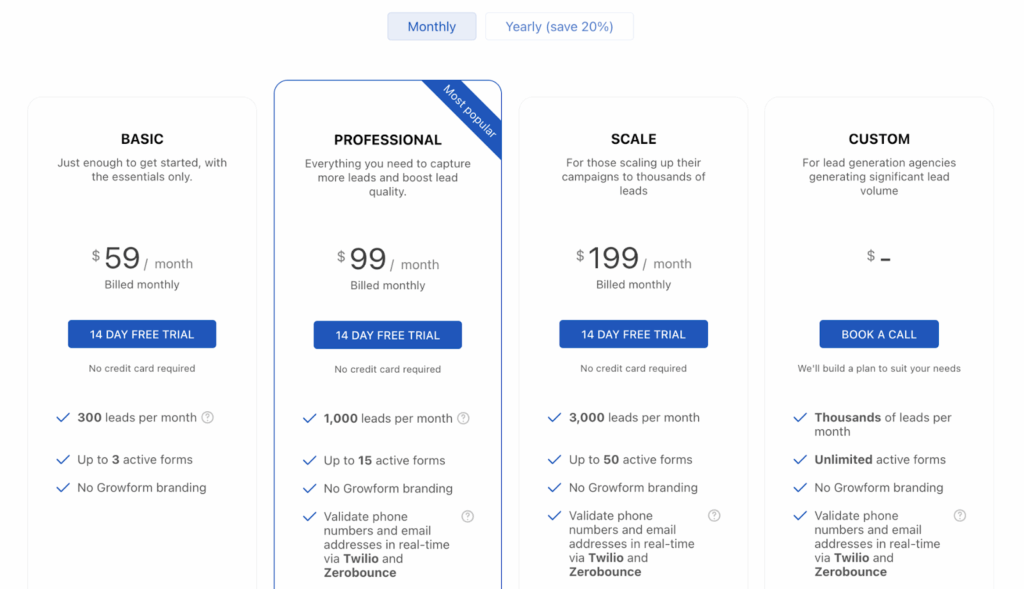
- Basic ($59/month): Ideal for getting started with essential features like multi-step forms, UTM tracking, and conditional logic.
- Professional ($99/month): Great for growing businesses. Supports more monthly leads and unlocks additional customization and performance features.
- Scale ($159/month): Built for high-volume lead generation. Offers advanced tracking, faster performance, and expanded usage limits.
- Custom (Contact for pricing): Tailored for enterprise needs. Includes custom domains, high lead volumes, premium support, and integrations like TrustedForm and DataSoap.
Every plan includes unlimited forms and a 14-day free trial, no credit card required.
Pros
- Built specifically for lead generation, not just general data collection.
- Multi-step forms come standard, helping reduce drop-offs and improve conversion rates.
- Easy to use, no coding required, even for advanced features like conditional logic or UTM tracking.
- Templates are based on proven conversion principles, making setup faster and more effective.
- Unlimited forms and fields, even on entry-level plans, with simple and transparent pricing.
Cons
- Analytics and A/B testing features are still in development
Typeform vs Google Forms vs Growform: Feature Comparison
| Feature | Typeform | Google Forms | Growform |
|---|---|---|---|
| Multi-Step Forms | ✅ Supported via logic jumps and one-question flows | ⚠️ Available only through section or page breaks | ✅ Native multi-step forms by default, designed to reduce drop-offs |
| Conditional Logic | ✅ Logic jumps on all plans | ✅ Basic conditional branching by sections | ✅ Full “and/or” logic rules across all plans included by default |
| Form Templates | ✅ Available | ✅ Basic templates | ✅ 100+ psychology-backed lead-generation templates |
| Brand Customization | ✅ Fonts, colors, themes on paid plans | ❌ Limited styling | ✅ Full branding control + custom CSS |
| Embedding Options | ✅ Basic embed links | ✅ Basic embed and share links | ✅ Lightweight embed code for any site |
| UTM & Hidden Field Tracking | ✅ Available | ❌ Manual or add-ons needed | ✅ Automatic capture of UTM, referral, and hidden fields |
| Pixel Firing (e.g., FB, GA) | ✅ Available from $99/month | ❌ Not supported | ✅ Available from $59/month |
| Lead Verification Tools | ❌ Not available natively | ❌ Not available | ✅ Supports integrations with verification platforms like TrustedForm and Jornaya |
| CRM & Tool Integrations | ✅ Zapier + native integrations | ✅ Google Sheets + add-ons | ✅ Native integrations + over 5,000 through Zapier |
| Analytics & Tracking | ✅ Basic performance reports | ✅ Summary charts + Sheets export | ✅ Built-in UTM tracking, pixel firing, and external integration support |
Why Do People Choose Growform
Built for Lead Generation
Most form tools try to do everything, handling surveys, signups, feedback, and more. Growform is different. It focuses solely on lead generation. That means every feature, template, and design choice is made with one goal in mind: helping you capture more qualified leads. You won’t find clutter or unnecessary options, just the tools you need to drive results.
Custom Branding & Design Control
Generic forms can hurt your brand. With Growform, you can fully customize your forms to match your branding, down to fonts, colors, button styles, and progress bars. You can even apply custom CSS for total control, ensuring every form feels like a natural extension of your website.
Fast, Reliable, and Lightweight
Slow-loading forms cost conversions. Growform forms are optimized for speed and hosted via Cloudflare, ensuring they load quickly on any device, anywhere in the world. Whether you’re embedding on a landing page or sharing directly, performance won’t get in the way of results.
Smarter Form Logic That Leads to Conversion
With Growform’s conditional logic, you can guide users through personalized form journeys based on their answers. This keeps respondents engaged, shortens completion time, and increases the quality of the leads you collect.
Transparent Pricing With Room to Scale
Growform offers simple, transparent pricing across all plans, without limits on the number of forms or fields you can use. That means no surprise upgrades or bottlenecks as your campaigns grow. Whether you’re managing one site or dozens, Growform scales with you.
Start Building High-Converting Forms With Growform
Typeform offers a strong visual experience, while Google Forms is all about simplicity. But when it comes to lead generation, both tools have clear limits. They fall short in logic, tracking, and being conversion-focused, making Growform a better option.
Growform is purpose-built to help you capture more leads. It offers an easy-to-use platform with multi-step forms, high-converting templates, and advanced tracking features that support real growth.
If you’re running paid ads, capturing inbound leads, or launching client campaigns, Growform gives you the tools to convert more visitors, without the complexity.
Try Growform free for 14 days, no credit card required.
Recent Posts
- Here’s Our Honest Review of Google Forms vs Jotform (vs Growform)
- Jotform Review: Is It The Best Form Builder For Lead Generation?
- Here’s Our In-Depth Comparison of Typeform vs Google Forms vs Growform
- Email Marketing Lead Generation 101 (+How To, Strategies, & Tools)
- Your Guide to Using Webflow Form Builder Effectively
